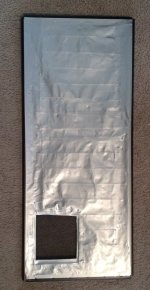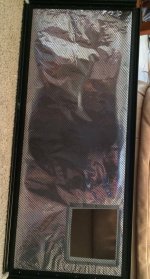xStaticSnow
New member
I found a "how to" thread on another forum which deals with ball pythons. The problem is that it's difficult to trap heat and humidity in a glass aquarium with a screen lid, so using aluminum foil and securing it with duct tape can really help insulate the cage better.
Although corns don't usually need very high humidity, I thought I might be helpful for some people. In western Montana it gets extremely dry in the winter, and since my corns are on aspen their enclosures get even more dry. Sometimes my adult corn has a difficult time shedding in the winter. I use to put a damp towel on his cage but keeping the towel wet was a bit of a pain, and it didn't work out for me very well.
Basically what you do is cut three sheets of tin foil which are about the same size as the lid you're using.
Lay all three sheets with the shiny side down, on the outside top of the screen lid. Use duct tape around the edges (sticky side is against the metal or plastic rim of the screen) to secure the tin foil.
Then use duct tape to cover the entire outside of the tin foil.
Use an exacto knife to cut a "window" in the duct tape and foil to allow for ventilation. I cut a small 5"x5" window in the lid for my ball python, but you would probably want to cut a much larger one for a corn snake so that the humidity doesn't get *too* high. I would say probably 10"x6" would be plenty of ventilation in a 20 gallon long screen.
Then fold a piece of duct tape over the edge left when you cut out the window.
In the end there should be places where the sticky side of the tape is exposed. The shiny side of the foil should help to reflect heat back into the tank and raise the ambient temperature a few degrees, and since the lid is partially covered some humidity should be trapped which can make it easier for your snake to shed if you live in a very dry area.
Here are some pictures!
Although corns don't usually need very high humidity, I thought I might be helpful for some people. In western Montana it gets extremely dry in the winter, and since my corns are on aspen their enclosures get even more dry. Sometimes my adult corn has a difficult time shedding in the winter. I use to put a damp towel on his cage but keeping the towel wet was a bit of a pain, and it didn't work out for me very well.
Basically what you do is cut three sheets of tin foil which are about the same size as the lid you're using.
Lay all three sheets with the shiny side down, on the outside top of the screen lid. Use duct tape around the edges (sticky side is against the metal or plastic rim of the screen) to secure the tin foil.
Then use duct tape to cover the entire outside of the tin foil.
Use an exacto knife to cut a "window" in the duct tape and foil to allow for ventilation. I cut a small 5"x5" window in the lid for my ball python, but you would probably want to cut a much larger one for a corn snake so that the humidity doesn't get *too* high. I would say probably 10"x6" would be plenty of ventilation in a 20 gallon long screen.
Then fold a piece of duct tape over the edge left when you cut out the window.
In the end there should be places where the sticky side of the tape is exposed. The shiny side of the foil should help to reflect heat back into the tank and raise the ambient temperature a few degrees, and since the lid is partially covered some humidity should be trapped which can make it easier for your snake to shed if you live in a very dry area.
Here are some pictures!


